| Toronto’s Dufferin Waste Management Facility |
Now I’m gonna talk garbage – more precisely, the stuff we Torontonians put in our Green Bins, and what happens to it.
Ever wonder about that? Earlier this month, three other Master Gardeners and I were invited by the Compost Council of Canada to join a day-long tour of organic waste-management facilities in Peel, Toronto and Durham.
I never knew there were so many ways to compost organics! But, I’ll focus on Toronto here. Because.
We toured the City’s Dufferin Waste Management Facility, pictured above, which be joined in about February 2014 by a new green bin facility at Disco Road. You can get a more detailed look at the process on this page. Think of this post as my executive summary.
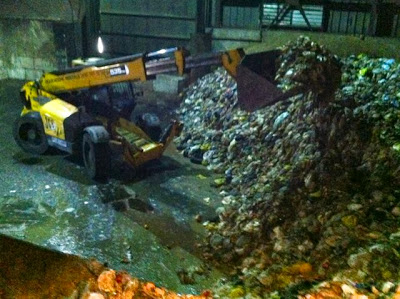 |
| It’s dark, it’s dank, it’s yours: the tipping floor at Dufferin |
Most of Toronto’s half-a-million single-family homes participate in our Green Bin program – and pilot programs are underway to bring the 50% of us who live in highrises into the act. The stuff we put in our green bins ends up here on the tipping floor.
Unlike Peel residents, who must use approved biodegradable or paper liners or put their organics directly into bins, Toronto lets us use regular plastic bags – simply to encourage more of us to use our green bins. And, unlike Peel or Durham, Toronto also accepts human and pet wastes such as sanitary products, disposable diapers and kitty litter.
 |
| Can you spot your bag? It ain’t pretty, but we all do it. |
That’s because Toronto uses a different composting method called anaerobic composting – anaerobic meaning “without air.” A closed system, it differs from how we compost in our back yards or the systems both Peel and Durham currently use. That’s aerobic composting, or “with air” just like the exercise. (Although, small anaerobic composters can be used at home for pet poop.)
After visual inspection on the tipping floor to be sure we haven’t thrown Aunt Madge or her BBQ tank out with the organics, all that yucky stuff gets scooped up onto a conveyer. Plastic bags and all.
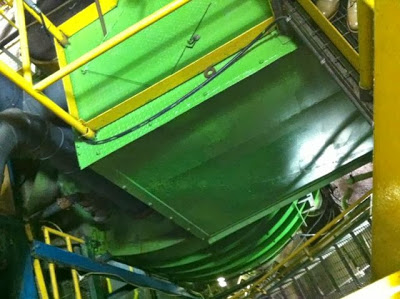 |
| Looking down on the giant agitator that opens up the bags |
It gets dumped along with water into a hydropulper. Like a giant blender, this agitates the mix just enough to open the plastic bags.
A giant rake then scoops off floaty stuff, like plastics. Heavy stuff, like the spoon that went into the bin with the table scraps, sinks. Both these bits are sent to landfill.
What remains is a gloppy, organic soup, ready for anaerobic digestion – a process similar to the way our stomach works. A recipe of anaerobic microorganisms and acids is added, and the thick liquid is piped into a big digestion tank.
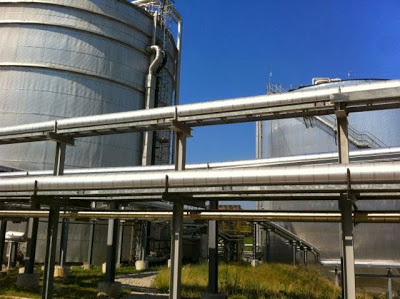 |
| Two digestion tanks at the Dufferin plant |
The circulating contents are kept at constant temperature – though not too hot to kill the organisms that now munch away on our organics. Therefore, this step doesn’t get hot enough to kill all bad bugs either.
That happens after the pulp has finished its time in the digester, and is squeezed out and sent for aerobic composting outdoors. Those long piles, called windrows, can get significantly hotter.
So why use anaerobic digestion at all? Some of the advantages:
Pre-digestion quickens the composting process, so it’s ready for use much faster.
Because it’s a closed system, anaerobic digestion captures most of the methane produced by decomposition, rather than releasing this greenhouse gas into the atmosphere like open dumps do. Methane and carbon dioxide gases are currently burned off, but the new Disco plant will eventually make use of it in their operations or use it to co-generate electricity. Right now, it’s considered a “dirty gas” but further refinement might one day make it possible to sell this byproduct as fuel.
Likewise, pre-treating anaerobically also captures most of the water in the organics, so it can’t run off to infiltrate groundwater with pollutants. The water can be treated or recycled for use at the plant.
To some extent, this closed system also reduces odors associated with waste management. A biofilter removes some of the unpleasantness, and a tall stack shoots any remaining smells high into the air. The pulp or digestate is mostly past the stinky stage when transferred for aerobic composting. There, it’s moistened and regularly turned, just like your home compost pile. After weeks or months, depending on the season, leftover plastic bits are screened out and the compost becomes plant food.
When we visited, one of the Dufferin anaerobic tanks was under repair, so we got to look in and imagine what it would be like to be digested in the absence of light or air inside a huge, metal stomach.
Not a fun thought, admittedly.
However, I’ll now be able to visualize what happens to the 44% (by weight) of our household waste that’s table scrapings or onion skins. We’ll have to find another way to dispose of Aunt Madge.
Oh, and if you’re wondering what to put out on the curb for collection in T.O., check out this Waste Wizard.

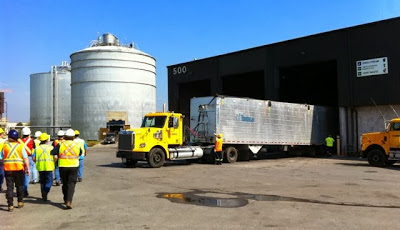
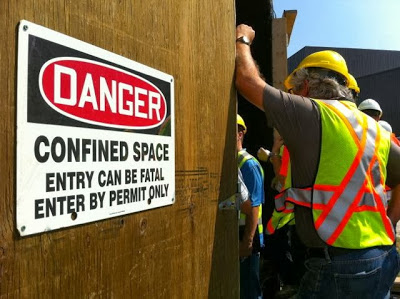



6 comments
Does this process kill off all the weed seeds and bad stuff we put in our green bins?
Yvonne, the anaerobic portion is pretty inhospitable, and we were told that the hot-composting, aerobic part of the process brings temps in the pile to 55˚C over a number of days. That's technically enough to kill off pathogens and seeds. Temps near the surface of the pile, however, might not reach this level. Also, they said they can't control seeds that wind blows on *top* of the pile. So the short answer is: yes, it gets most of the bad stuff. I understand that it's tested for pathogens before release, but I don't know if they can guarantee 100% weed-seed-free.
Great post. I use this facility nearly daily – to drop off yard waste. I've always been impressed by the lack of smell, considering all the waste we see each time we drive down to the yard waste section. Good info. Thanks for sharing.
Good to hear, Heidi. Thanks for dropping by.
I have spent 10 summers in Nova Scotia, we own a cottage there, and I am still completely mystified by the Canadian recycling rules. Nevertheless, the Green Bin is a favorite of mine. I love being able to put ANYTHING compostable in it. Before reading your post, I never wondered how it all got composted. I naively imagined it all went into a simple compost bin like I use at my (not summer) house in USA. Next summer, I will seek out the compost station near where in live on the South Shore of Nova Scotia and see if it is as sophisticated as the one in Toronto. I love the idea of converting the methane gas into something useful
Amy, one organic that *can't* be composted anaerobically (I meant to mention it) is hair — pet hair or human hair, both great sources of slow-release nitrogen. I wish I'd asked about it, but my assumption is that it mats up and clogs the machinery or pipes. Keeping the compost soup moving is essential to the process, and a clog would be costly. We can keep our hair for our backyard bins, though.